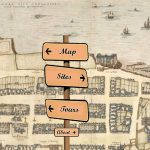Projects
The following projects are currently being undertaken by members of the St Andrews Institute of Historical Research:
Mediaeval St Andrews began as a team-taught honours module offered in the School of History and has evolved into a cross-faculty collaborative project. Bringing together a range of projects across the University, the principal purpose is to collect, research, teach and share knowledge about St Andrews up to the Reformation.

The Mediaeval St Andrews team has developed a mobile app that lets you explore the medieval sites of St Andrews and includes information, videos, images and more.
Download the Mediaeval St Andrews App in iTunes here and on Google Play here.
Scotland and the Flemish People
The overall aim of the Scotland and the Flemish People Project is to provide an accessible overview of the impact of the Flemish people on Scotland and the historical interactions between Scotland and Flanders (the Low Countries or modern-day Belgium). Combining genealogical and historical research, the project reassesses the settlement of Flemings in Scotland – their distribution and local impact – and reviews the role of the Flemish in the broad sweep of Scottish history.
The Institute of Scottish Historical Research currently hosts this innovative project which seeks to establish the full extent of Scotland’s links with the ‘Wider World’ particularly in the Early Modern Period.
Records of the Parliaments of Scotland
The Records of the Parliaments of Scotland to 1707 (RPS) is a fully searchable database containing the proceedings of the Scottish parliament from the first surviving act of 1235 to the union of 1707. The culmination of over ten years’ work by researchers from the Scottish Parliament Project based in the School of History at the University of St Andrews, the online edition seeks to make this key historical source freely available to all in a technologically advanced and user-friendly format.
Scotland, Scandinavia and Northern Europe Database
The Records of the Parliaments of The SSNE database is an online research tool which originated as a facility to store data for two researchers at the University of Aberdeen’s Scotland and Scandinavia Project (1995-1999), Prof Steve Murdoch and Dr Alexia Grosjean. Now based permanently at the University of St Andrews, the database represents an ongoing project of interest to historical researchers, human geographers, genealogists and those with an interest in the development of online research and/or teaching tools.
LASH-BASH
In 2007, the ISHR secured, through competitive tender, the management of the LASH-BASH project (the curious acronym deriving from the list of articles and books relating to Scottish History, published originally in the Scottish Historical Review). These lists are now managed by the Royal Historical Society [RHS] and the LASH-BASH project is funded by the Scottish Historical Review Trust [SHRT], allowing the Institute to employ a team of postgraduates to check the bibliographical details on lists sent out four times a year of books and articles published in the field of Scottish history. Typically, this involves the verification or addition of such information as date ranges, book chapters, page references, name indexes, etc., in addition to checking entries for relevance and offering translations of, for example, Gaelic titles. The checked entries are then uploaded and incorporated into the Bibliography of British and Irish History [BBIH] database.
LASH-BASH in the ISHR is co-ordinated by Dr Christine McGladdery.
Dark Ages Studies
In 1955 the University of St Andrews appointed F. T. Wainwright, a pupil of the great Sir Frank Stenton, to the post of Senior Lecturer in Dark Age Studies. Wainwright held this post until his early death in 1961. Since Wainwright’s time St Andrews has continued to show a commitment to teaching and research in this area and first Nicholas Brooks and then Barbara Crawford took on Wainwright’s mantle. In the 1990s, together with a nucleus of committed colleagues, both within and beyond the University, Barbara Crawford established the Committee for Dark Age Studies with the aim of promoting the interdisciplinary and cross-cultural study of early medieval Scotland within its Insular and European context. Since Barbara Crawford’s retirement in 2002, Alex Woolf has taken on the chairmanship of the committee.
Committee for Dark Age Studies publications can be purchased online through the University of St Andrews.
Enquiries should be made to Alex Woolf ([email protected]).